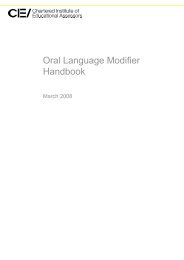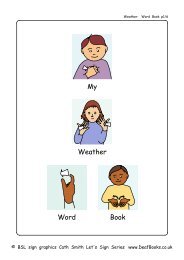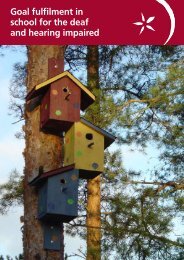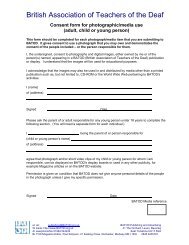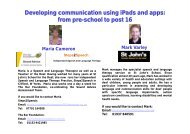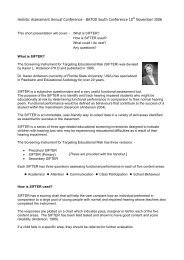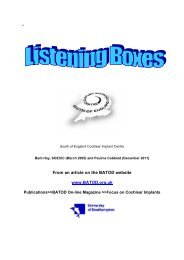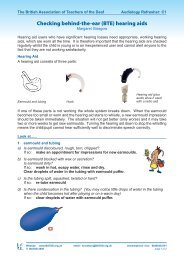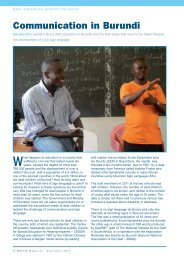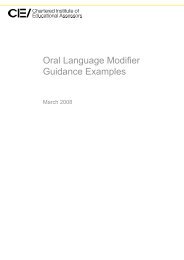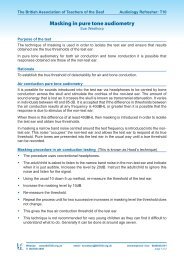Strategies for supporting dyslexic deaf pupils - batod
Strategies for supporting dyslexic deaf pupils - batod
Strategies for supporting dyslexic deaf pupils - batod
Create successful ePaper yourself
Turn your PDF publications into a flip-book with our unique Google optimized e-Paper software.
<strong>Strategies</strong> <strong>for</strong> <strong>supporting</strong> <strong>dyslexic</strong> <strong>deaf</strong> <strong>pupils</strong><br />
Prue Ruback, Senior Lecturer in Education, University of Hert<strong>for</strong>dshire<br />
(<strong>for</strong>merly Chief Verifier <strong>for</strong> SpLD professional training courses)<br />
One of the core deficits found in many <strong>dyslexic</strong>s is<br />
the inability to process sounds efficiently. Their<br />
impaired phonological processing skills make the<br />
segmentation and blending of sounds very difficult<br />
and this has predictable implications <strong>for</strong> their<br />
acquisition of literacy skills.<br />
The <strong>deaf</strong> pupil may have similar difficulties learning<br />
to read and, in both cases, the visual route to<br />
reading might be preferable.<br />
With a <strong>deaf</strong> <strong>dyslexic</strong>, the challenge <strong>for</strong> their teachers<br />
is to find material which is both helpful and<br />
stimulating.<br />
What follows below is a set of pointers which might<br />
be considered when working with HI <strong>dyslexic</strong><br />
readers and spellers.<br />
Check that the picture always supports the<br />
written text. If in doubt cover up the text and<br />
see how helpful the visual images are in<br />
<strong>supporting</strong> decoding.<br />
For emergent readers always have large,<br />
plastic feely letters when working on word level<br />
work. These provide multisensory opportunities<br />
<strong>for</strong> rein<strong>for</strong>cement of letter shapes and sounds,<br />
using tactile materials. Dyslexic learners often<br />
prefer the kinaesthetic route to learning, so any<br />
opportunity that enables them to manipulate<br />
tactile letters will rein<strong>for</strong>ce their learning.<br />
Make use of visual analogy wherever possible.<br />
For example, if a child can read and spell their<br />
favourite football ‘team’ then they can construct<br />
cream and dream by analogy.<br />
Use colour to highlight visual patterns in words.<br />
A small whiteboard and coloured pens can be<br />
both motivating and interactive. The aim<br />
should always be to involve the learner in<br />
metacognitive choices, rather than learning by<br />
rote. So, when tackling phonics and spelling<br />
onset and rime chunks (where c is the onset<br />
and -at is the rime), can be assembled visually<br />
as well as aurally/auditorially.<br />
eg f-at, r-at, s-at, b-at, m-at, h-at, p-at<br />
The fact that the pupil has been given the<br />
chunk -at means that the medial vowel sound<br />
does not have to be worked out: it is a<br />
constant, allowing rapid assembly of similar<br />
words.<br />
Syllable division, which is often problematical<br />
<strong>for</strong> <strong>dyslexic</strong>s, can be tackled in a kinaesthetic<br />
way, by tapping on the table, clapping out or<br />
counting ‘chin-bumps’ in a pupil's name Chris/<br />
to /pher. Other visually effective methods <strong>for</strong><br />
helping to identify the correct number of<br />
syllables would be to construct the whole word<br />
with plastic letters, or to write out the whole<br />
word, which can then be segmented and<br />
marked up with coloured pens or highlighters.<br />
Make as much use as possible of interactive<br />
early reading programs on the computer, where<br />
every word can be highlighted individually, as<br />
they are read aloud. This adds a visual<br />
dimension to the spoken text.<br />
Another helpful feature of incorporating ICT into<br />
early literacy is that it can provide all the overlearning<br />
and rein<strong>for</strong>cement needed <strong>for</strong><br />
<strong>dyslexic</strong>s, whilst simply reading to an adult or<br />
parent doesn't have the same ‘street-cred’ or<br />
appeal. The computer is non-judgemental and<br />
doesn't get tired, allowing the <strong>dyslexic</strong>s the<br />
opportunities they need <strong>for</strong> consolidation of<br />
spelling patterns, new vocabulary or whatever<br />
has to be committed to long-term memory.<br />
Legibility of handwriting can be an issue <strong>for</strong><br />
<strong>dyslexic</strong>s. Indeed some <strong>dyslexic</strong>s use<br />
indecipherable handwriting to camouflage their<br />
imperfect spelling knowledge, preferring the<br />
teacher to make sense of their written work.<br />
Others have poor fine-motor control and some<br />
simply find putting pen to paper a real strain.<br />
Word processing packages which incorporate<br />
predictive text, speech synthesis, a variety of<br />
spelling options, based on previous choice can<br />
all free up the secretarial aspects of writing to<br />
allow the student to concentrate exclusively on<br />
composition.<br />
For <strong>dyslexic</strong>s, the word processing facilities to<br />
enlarge text, to change the background colour<br />
of the screen and to select a font which is<br />
©BATOD Magazine November 05 23
easier to process, such as Comic Sans or<br />
Sassoon cursive will all be of benefit.<br />
Sequencing can be an area of difficulty <strong>for</strong><br />
<strong>dyslexic</strong> learners of all ages. So alphabet<br />
friezes, number lines, high frequency word lists,<br />
class lists etc, should be accessible and freely<br />
available. Dyslexics under-per<strong>for</strong>m when under<br />
pressure, so a quick glance at a handy aidememoire<br />
can remove an added layer of<br />
difficulty when practising their literacy skills.<br />
Strategically positioned visual timetables,<br />
possibly with pictures or icons, depending on<br />
the age of the pupil, can help to reassure the<br />
primary school <strong>dyslexic</strong> about classroom<br />
routines and the structure of the school day.<br />
Homophone and homonym confusions often<br />
seem like intractable problems <strong>for</strong> the <strong>dyslexic</strong><br />
person. Having someone to discuss the<br />
context of the word with, someone who can<br />
explore how to construct a mnemonic <strong>for</strong><br />
tackling confusing spelling patterns, or<br />
someone who can provide other multisensory<br />
ways of approaching literacy will be of<br />
enormous benefit to the <strong>deaf</strong> <strong>dyslexic</strong>. So the<br />
individual support of a trained teaching<br />
assistant/Teacher of the Deaf will immeasurably<br />
enhance the ability of the <strong>deaf</strong> <strong>dyslexic</strong> to make<br />
progress with literacy.<br />
enough to put them into any coherent order. At<br />
KS2 where text cohesion is a requirement, ICT<br />
programs which allow them to mind-map on<br />
screen will help to capture this range of<br />
tangential thoughts, sort and order them and<br />
store them <strong>for</strong> possible inclusion at a later date.<br />
There is an organisation called patoss which is<br />
the Professional Association of Teachers of<br />
Students with Specific Learning Difficulties.<br />
Patoss hosts an annual conference, runs local<br />
groups <strong>for</strong> SpLD professionals and publishes a<br />
bi-annual professional journal. It also maintains<br />
a register of SpLD tutors and publishes a list of<br />
useful resources, by age and category.<br />
www.patoss-dyslexia.org<br />
There is a great deal of overlap between the<br />
problems encountered by the <strong>deaf</strong> student and the<br />
<strong>dyslexic</strong> student and the challenge <strong>for</strong> the<br />
professional working with a combination of both<br />
difficulties is to be continually updating oneself about<br />
new materials, strategies and approaches.<br />
English is a crazy language<br />
In what language do people recite at a play and play<br />
at a recital<br />
Have noses that run and feet that smell<br />
How can a slim chance and a fat chance be the<br />
same thing, while a wise man and a wise guy are<br />
opposites<br />
There is a wealth of games, software, books<br />
which could be of benefit to individual students<br />
but it is invidious to recommend specific ones,<br />
as many are related to learning style, the age<br />
of learner and the personal preference of the<br />
teacher.<br />
For older <strong>dyslexic</strong>s the sequencing of ideas <strong>for</strong><br />
a written assignment can present a challenge.<br />
Sometimes ideas come in such a random way,<br />
that <strong>dyslexic</strong>s cannot remember them long<br />
Mind-map - using mind-maps<br />
24 ©BATOD Magazine November 05



